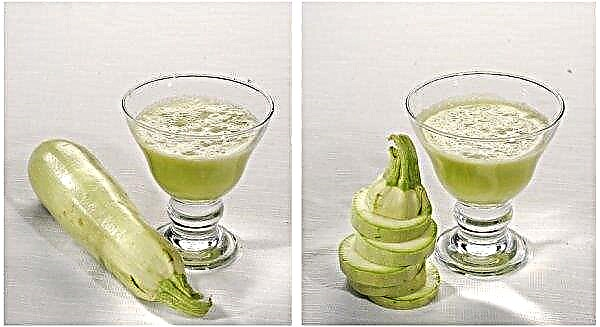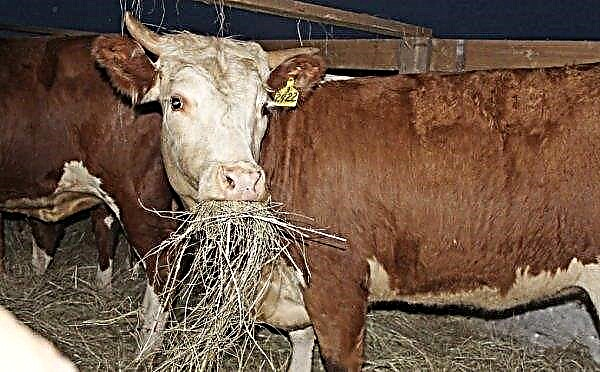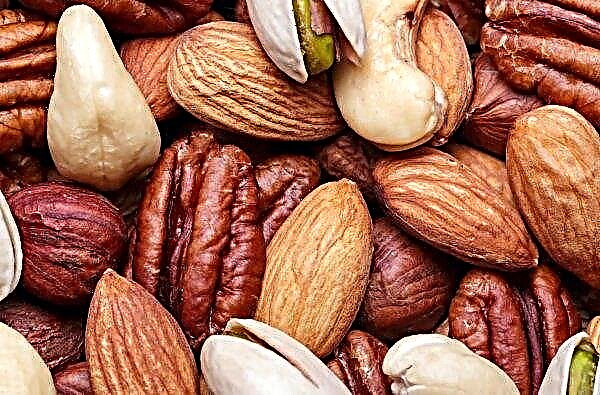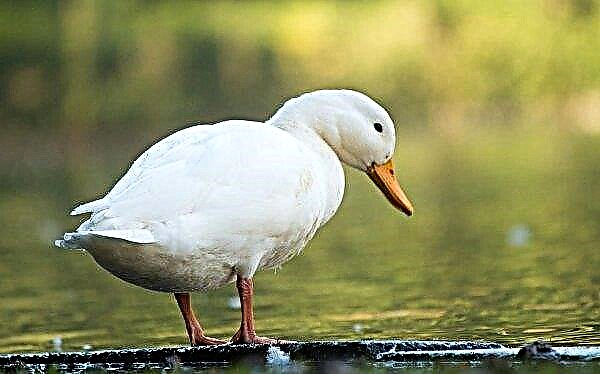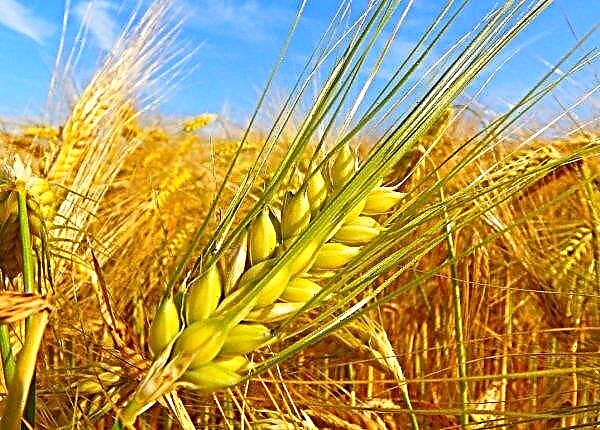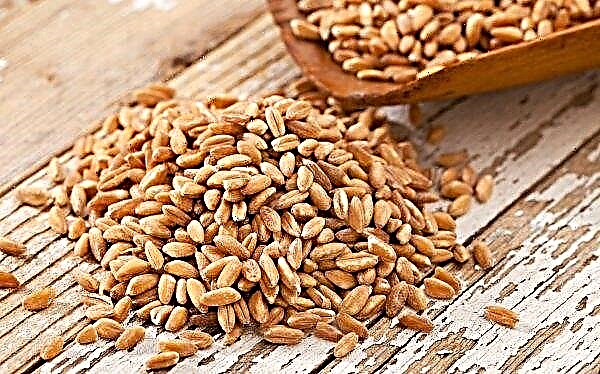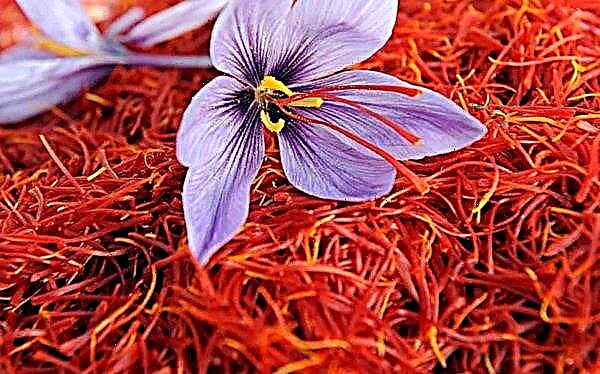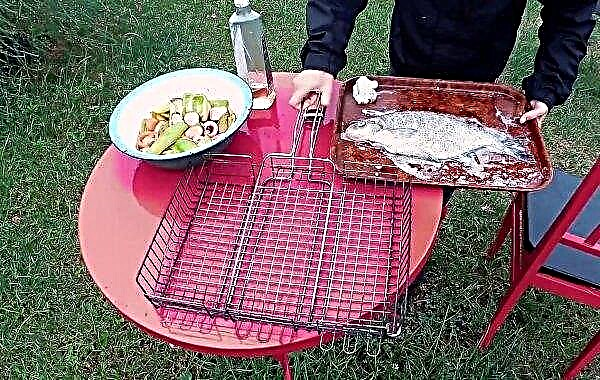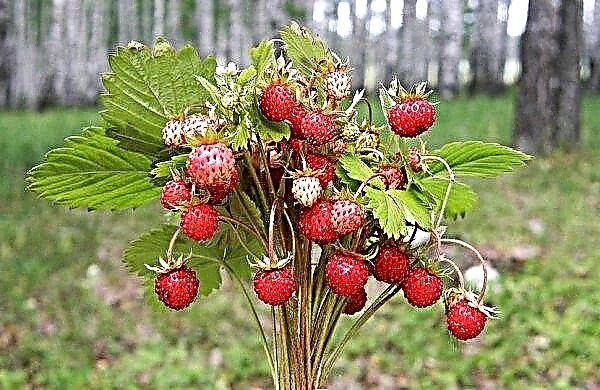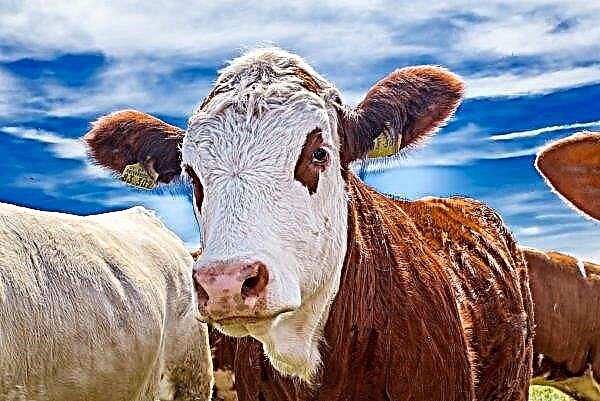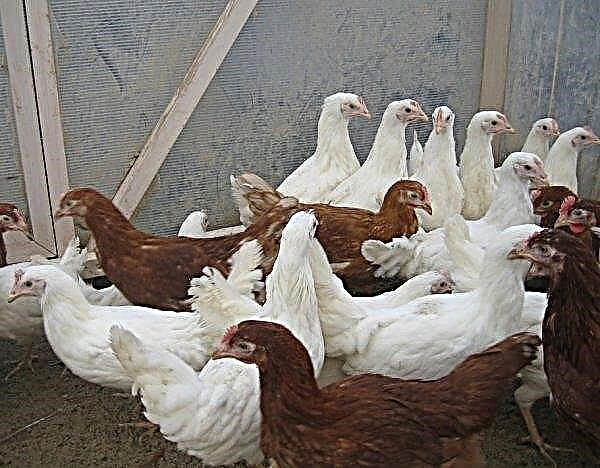Tomatoes of a relatively new Auria variety are distinguished by the non-standard orientation of their fruits in space, as well as by powerful productivity. Their features and methods of cultivation will be discussed later.
Grade description
This tomato variety can be immediately distinguished from others by oblong fruits, reaching up to 15 cm in length, with a forked tip on them. Other botanical features of Auria tomatoes can be judged from the following:
- this variety is capable of producing up to 5 kg of tomatoes from a bush;
- the weight of each fetus varies from 80 to 150 g;
- plant height reaches 1.8 m;
- the fruit is saturated red;
- its flesh is sweet and sour in taste, dense and not very juicy;
- these tomatoes are eaten raw, but they are especially good in canned form.
Did you know? Botanists claim that tomatoes are berries, the Supreme Court of the United States ranked tomatoes as vegetables, and in the European Union in 2001 decided that tomatoes are still fruits.
Advantages and disadvantages
- The increasing popularity that this relatively fresh tomato variety is gaining is evidence of its advantages, which are expressed in:
- high productivity;
- ability to resist diseases and pests;
- universality of use;
- good presentation;
- resistance to lack of moisture;
- lack of tendency to crack fruit;
- high transportation qualities;
- the same size of the vast number of fruits;
- ability to long storage.

- The disadvantages of the variety are much less marked, most often among them are called:
- some dryness of the pulp;
- excessive severity of brushes with fruits, which breaks thin stems;
- the exactingness of the plant for the selection of top dressing;
- insufficient presence of Auria seeds in a specialized trading network.
Sowing seeds for seedlings
If tomato seeds of this interesting variety are already available, it is necessary to carry out some preparatory work with them before sowing, and then plant them in the soil according to agricultural rules.
Did you know? Tomatoes, which came to Europe from America in the wild only in the middle of the 16th century, currently number more than 10 thousand of their varieties.
The timing
Typically, seeds begin to be prepared for sowing at the end of February. To more accurately determine this time depending on the region, it should be assumed that 2 months should pass from the moment of sowing the seeds to the planting of the sprouts at a constant place of growth.

The soil
Sow the seeds should be in the prepared soil, which is best purchased in specialized stores. If you have to cook it yourself, then you need to take the earth and mix it with humus in equal proportions with a small addition of peat to the mixture. But before that, the soil needs to be disinfected, for which it is watered with a concentrated solution of potassium permanganate, then it is heated for a third of an hour in an oven at a temperature of up to 190 degrees and after that they leave the soil in open containers for a couple of weeks.
Capacity for growing
Before sowing seeds, the prepared soil is placed either in ordinary plastic cups, or in low wooden boxes with a length and width that would ensure their convenient placement in the places intended for them, or in plastic containers.

Pods from peat, especially designed for sowing seeds in them, are very popular among vegetable growers today. They are ordinary peat, compressed in the form of washers of different diameters, to which mineral fertilizers and substances stimulating plant growth are added. On top of the peat tablet is a recess in which the seed is placed.
Seed preparation
Prepare tomato seeds for sowing as follows:
- They are calibrated by removing too small and damaged seeds.
- The selected material is poured into a salt solution.
- After a quarter of an hour, the empty seeds that have come up are removed, and the ones that settle to the bottom are picked up, washed in clean water and dried.
- Then the dried seed material is treated with a one percent solution of potassium permanganate for a third of an hour for disinfection.
- After that, the seeds are placed on wet gauze lying on a saucer, which must be kept moist all the time with a spray gun at a temperature of at least 20 degrees Celsius. Seeds are aged on gauze until they are pecked. During this period, it is useful for hardening in order to increase resistance to temperature extremes and improve productivity several times to put them in the refrigerator for half a day.
Sowing seeds
Hatching seeds are planted in prepared containers with soil or in peat tablets to a depth of 6 mm. The distance between planted seeds should be at least 3 cm.
Important! No more than two seeds should be placed in each well.
Seedling Care
The final stage in the process of sowing seeds is to create a greenhouse effect, which is carried out using a plastic film. It covers containers with sown soil, which are placed in places with a constant temperature of at least 24 degrees Celsius and with good lighting. Watering the sown soil should be carried out as necessary, when it begins to dry out, but in such a way that it is in no case waterlogged. Seedlings are fed by bird droppings or fermented mullein for the first time 3 weeks after emergence. Then its dive is also carried out.

Seedling hardening
As soon as 3 leaves appear on the sprout, it is necessary to harden the tomato, for which they begin to air at a lower temperature for 5 minutes, followed by a constant increase in the hardening period. This operation not only increases the resistance of seedlings to temperature extremes, but also increases productivity by half.
Planting seedlings in a permanent place
Before planting seedlings in open ground, it is important to find a suitable place for this, where the tomatoes will feel as comfortable as possible. Usually, for this, a hill is chosen that is protected from strong winds. For growing tomatoes, the soil is most suitable on which their predecessors were legumes, lettuce and various root crops.
Depending on the region, tomato seedlings are planted in open ground from mid-May to early June. Before this, the soil is fertilized with organic top dressing at the rate of 1 bucket for each square meter. When planting seedlings, the distance between the wells should be at least 60 cm. First, a small amount of a low-percentage potassium permanganate solution must be poured into each well to disinfect the soil.Important! In no case should you plant tomatoes on the soil on which potatoes previously grew.
Neatly extracted from the tank, an earthen lump with seedling roots is placed in a hole to such a depth that the earth will fill the plant stem to the first leaves located on it.

Growing Features
This tomato variety is demanding on the conditions of irrigation and the composition of top dressing.
Watering
After the tomatoes are planted in the ground in a permanent place, they should not be watered for a couple of days. Then, watering should be organized in such a way that, being regular, it should be moderate at the same time. To do this, you must constantly monitor the condition of the soil. In cloudy weather, a couple of liters of water will last for a week. In warmer weather, watering twice a week is required. Auria is watered by carefully pouring water directly under the bush. Water is not allowed on the leaves of the plant.
Top dressing
This tomato variety requires fertilizer containing a high concentration of nitrogen during the active growth of green mass. Any organic top dressing is well suited for this. And during the period of growth and ripening of fruits, tomatoes already require fertilizers, in which there is a lot of potassium and phosphorus. It is very useful to use wood ash as a top dressing during the ripening period of tomatoes.
Video: Features of Auria Tomatoes
Stepson
Since Auria is actually a liana, it is mandatory to stepchild it. The plant is limited to 2 stems, and excess pagons are eliminated. Also, in this variety, the lower tier of leaves will certainly be eliminated, and leaves (with the exception of a couple of pieces) growing near fruit brushes will also break off.
Soil care
Tomato Auria loves loose soil above its roots. Therefore, after the next watering, or at least once every half a month, you should loosen the soil near the plants, while weeding the weeds. At the same time, in the first 3 weeks the soil is loosened to a maximum depth of 12 cm, and later, in order not to damage the root system, the depth of loosening is reduced to 8 cm.
As the tomato grows to improve the temperature and humidity conditions, loosening is supplemented by hilling with moist soil. Sometimes instead of hilling, a weekly mulching is performed with humus soil, poured on loosened soil.
Bush tying
This tomato variety, growing to a height of 1.8 m and forming heavy bunches of fruits, simply can not do without a garter. In addition, the garter contributes to the maximum penetration of sunlight into the green mass and the fruits of the tomato and protects them from touching the ground, which is fraught with infection by rot, infection or pests.

Garter of tomatoes is most often carried out in the following ways:
- with the help of stakes stuck into the ground near a tomato bush, to which the stem of the plant is attached to a synthetic cord with a low coefficient of rigidity;
- through trellises, to which, using the same cords, the stem and branches of a tomato are tied;
- using cells from metal or wood that surround the plant and prevent it from falling to the ground;
- using a special portable metal mesh, which serves as a backup to the plant.
Preventative treatment
Although breeders have obtained a sufficiently high resistance to diseases from the Auria variety, it manifests itself only by scrupulously following agrotechnical rules and carrying out timely preventive measures.
If this is absent, then the plant may have problems in the form of:
- vertebral rot, which occurs with acidic soil and is prevented or eliminated by adding dolomite flour to the soil;
- rotting of the upper part of the bushcaused by a deficit of moisture in the ground and eliminated by timely watering, as well as the treatment of the affected part with a one percent solution of Bordeaux fluid;
- brown spotting (cladosporiosis), most often occurring in closed ground, but also in open ground, in which dark spots form on the leaves and which is prevented by the exact observance of irrigation rules;
- parasitesrepresented by aphids, whiteflies and the Colorado potato beetle, which are controlled by insecticides such as the Commander, Prestige or Lightning.

This original tomato, which gives many fruits, especially tasty in canned form, resistant to diseases and easy to transport, requires some effort during its cultivation. Nevertheless, the young Auria tomato variety is already quite widespread and is rapidly increasing the number of its fans.
Reviews of tomatoes Auria
Auria sat for a long time, it produced few fruits, and now it has begun to pour fruits at once and is going to harvest. After a day, I take 2-5 fruits from each bush. The pinking fruits are reddish, and after reading reviews I expected a technical taste. But no, good. Very fleshy, juicy, sweet, soft and grainy. The color of ripe fruits is dark red, they become soft to the touch. In the first brush many small fruits turned red, the higher the brush, the larger the fruit. BUT! This is the ONLY variety that periodically suffers from the top. He did not have enough, like the rest, one treatment with dolomite and blackened fruits appear in 4-5 brushes (surprised, but 2 bushes out of six suffer, on four - there is not even a hint). The variety is interesting, very convenient for canning, the yield is gaining gradually, with every day is getting better. This is apparently due to his thermophilicity, and he likes the middle of summer. But here is the top rot ... It's a shame to throw out even single sick ovaries. I never had any problems with the vertex, but here it is immediately noticeable that this is a weak spot. Most likely I will leave this variety for another year, but in any case fewer bushes and with caution against vertebral rot. It’s necessary to additionally “strengthen” the middle ridge of the greenhouse with dolomite to safely plant tall, long-fruited varieties there. Of all my long-fruited fleshy varieties, Auria has the most classic bush. It is easier to maintain in childhood and adolescence, it curls less and bends. But the peak loves him more than anyone, and heat loving is on the verge. In principle, most likely this variety is not in our climate zone. He would have somewhere in the south, but on alkaline soils, there he would have turned. Our sour swamp slowly trolls it. Another feature is the tender soft green lime greens. In this variety, the stems mature later than the rest, remain tender for too long. The rope leaves a dry mark, even in my greenhouse blown through with drafts. This means a very high probability of catching sores if it gets into high humidity.
But in general - a powerful, heat-loving, productive exotic plant. My opinion is very one-sided, because I do not use chemistry for feeding and disease prevention. My set is ash, mash, dolomite flour, iodine with whey at the beginning of the season. All plants in one trunk.
http://dacha.wcb.ru/index.php?s=efdffef745fc79ab4cebbd922e55297a&showtopic=52280&view=findpost&p=914225

